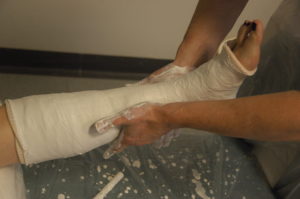 A study has confirmed that a new form of casting offers an alternative to invasive surgery in older people who have unstable ankle fractures.
A study has confirmed that a new form of casting offers an alternative to invasive surgery in older people who have unstable ankle fractures.
The study comparing initial treatment with close contact casting (CCC) and the usual open reduction and internal fixation (ORIF) surgery was conducted by researchers at the University of Oxford’s Nuffield Department of Orthopaedics, Rheumatology and Musculoskeletal Sciences (NDORMS) and funded by the National Institute of Health Research (NIHR) Oxford Biomedical Centre (BRC).
The study, published today (27 March) in JAMA: The Journal of the American Medical Association, was a follow-up to a randomised clinical trial involving 620 participants from 24 NHS hospitals, whose results were published in October 2016.
That trial, led by Professor Keith Willett, found that ankle function at six months was similar in those who had CCC and those who underwent surgery. People who had a cast were less likely to have infections or wound problems than those who had surgery.
However, one in five people in the casting group had to have surgery later because their fracture was not healing in the right position. There was more abnormal healing of the fracture seen on radiographs (malunion) in the casting group (15 per cent, compared to 3 per cent for surgery).
Over six months close contact casting was around £650 cheaper than surgery, and was very likely to be cost effective at current NHS thresholds.
This follow-up study was conducted to determine if the equivalence found in the original study persisted after three years.
Dr David Keene, NIHR Postdoctoral Research Fellow and NDORMS Research Fellow in Trauma Rehabilitation, who led the study, said: “After three years, we found that equivalence in function between close contact casting and immediate surgery was maintained.”
He said that for the people whose fractures were not healing in the correct position at six months, ankle function at three years was poorer whether treated by casting or surgery.
“These longer-term outcomes will help surgeons and patients to make informed decisions about the right course of action for them,” Dr Keene explained. “Our findings indicate that treatment of ankle fractures in older adults should focus on obtaining and maintaining a reduction until union, by the most conservative means possible.”
The CCC, a lower-leg cast, was developed by Professor Keith Willett and Robert Handley with the aim of offering an alternative to surgery, the usual method of treating unstable ankle injuries. The surgery aligns and holds the bones in position with metal screws and/or plates during healing. In older adults surgery outcomes are uncertain because of the frailty of bone and skin.
Watch videos of the Ankle Injury Management Trial and Close Contact Casting.